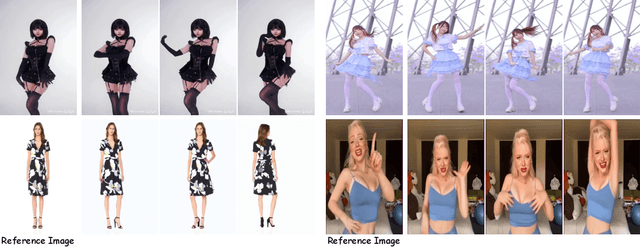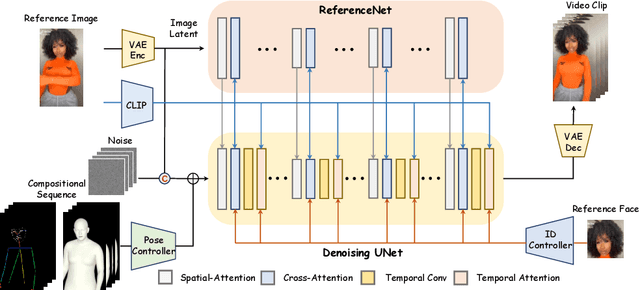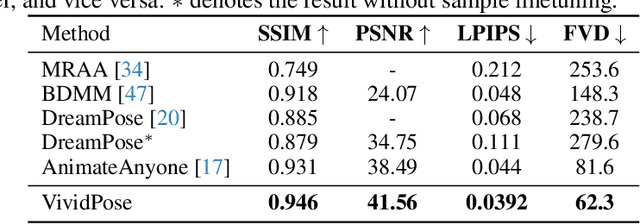Chengming Xu
CrossVTON: Mimicking the Logic Reasoning on Cross-category Virtual Try-on guided by Tri-zone Priors
Feb 20, 2025



Abstract:Despite remarkable progress in image-based virtual try-on systems, generating realistic and robust fitting images for cross-category virtual try-on remains a challenging task. The primary difficulty arises from the absence of human-like reasoning, which involves addressing size mismatches between garments and models while recognizing and leveraging the distinct functionalities of various regions within the model images. To address this issue, we draw inspiration from human cognitive processes and disentangle the complex reasoning required for cross-category try-on into a structured framework. This framework systematically decomposes the model image into three distinct regions: try-on, reconstruction, and imagination zones. Each zone plays a specific role in accommodating the garment and facilitating realistic synthesis. To endow the model with robust reasoning capabilities for cross-category scenarios, we propose an iterative data constructor. This constructor encompasses diverse scenarios, including intra-category try-on, any-to-dress transformations (replacing any garment category with a dress), and dress-to-any transformations (replacing a dress with another garment category). Utilizing the generated dataset, we introduce a tri-zone priors generator that intelligently predicts the try-on, reconstruction, and imagination zones by analyzing how the input garment is expected to align with the model image. Guided by these tri-zone priors, our proposed method, CrossVTON, achieves state-of-the-art performance, surpassing existing baselines in both qualitative and quantitative evaluations. Notably, it demonstrates superior capability in handling cross-category virtual try-on, meeting the complex demands of real-world applications.
SVFR: A Unified Framework for Generalized Video Face Restoration
Jan 03, 2025



Abstract:Face Restoration (FR) is a crucial area within image and video processing, focusing on reconstructing high-quality portraits from degraded inputs. Despite advancements in image FR, video FR remains relatively under-explored, primarily due to challenges related to temporal consistency, motion artifacts, and the limited availability of high-quality video data. Moreover, traditional face restoration typically prioritizes enhancing resolution and may not give as much consideration to related tasks such as facial colorization and inpainting. In this paper, we propose a novel approach for the Generalized Video Face Restoration (GVFR) task, which integrates video BFR, inpainting, and colorization tasks that we empirically show to benefit each other. We present a unified framework, termed as stable video face restoration (SVFR), which leverages the generative and motion priors of Stable Video Diffusion (SVD) and incorporates task-specific information through a unified face restoration framework. A learnable task embedding is introduced to enhance task identification. Meanwhile, a novel Unified Latent Regularization (ULR) is employed to encourage the shared feature representation learning among different subtasks. To further enhance the restoration quality and temporal stability, we introduce the facial prior learning and the self-referred refinement as auxiliary strategies used for both training and inference. The proposed framework effectively combines the complementary strengths of these tasks, enhancing temporal coherence and achieving superior restoration quality. This work advances the state-of-the-art in video FR and establishes a new paradigm for generalized video face restoration. Code and video demo are available at https://github.com/wangzhiyaoo/SVFR.git.
FitDiT: Advancing the Authentic Garment Details for High-fidelity Virtual Try-on
Nov 22, 2024



Abstract:Although image-based virtual try-on has made considerable progress, emerging approaches still encounter challenges in producing high-fidelity and robust fitting images across diverse scenarios. These methods often struggle with issues such as texture-aware maintenance and size-aware fitting, which hinder their overall effectiveness. To address these limitations, we propose a novel garment perception enhancement technique, termed FitDiT, designed for high-fidelity virtual try-on using Diffusion Transformers (DiT) allocating more parameters and attention to high-resolution features. First, to further improve texture-aware maintenance, we introduce a garment texture extractor that incorporates garment priors evolution to fine-tune garment feature, facilitating to better capture rich details such as stripes, patterns, and text. Additionally, we introduce frequency-domain learning by customizing a frequency distance loss to enhance high-frequency garment details. To tackle the size-aware fitting issue, we employ a dilated-relaxed mask strategy that adapts to the correct length of garments, preventing the generation of garments that fill the entire mask area during cross-category try-on. Equipped with the above design, FitDiT surpasses all baselines in both qualitative and quantitative evaluations. It excels in producing well-fitting garments with photorealistic and intricate details, while also achieving competitive inference times of 4.57 seconds for a single 1024x768 image after DiT structure slimming, outperforming existing methods.
Robust Network Learning via Inverse Scale Variational Sparsification
Sep 27, 2024



Abstract:While neural networks have made significant strides in many AI tasks, they remain vulnerable to a range of noise types, including natural corruptions, adversarial noise, and low-resolution artifacts. Many existing approaches focus on enhancing robustness against specific noise types, limiting their adaptability to others. Previous studies have addressed general robustness by adopting a spectral perspective, which tends to blur crucial features like texture and object contours. Our proposed solution, however, introduces an inverse scale variational sparsification framework within a time-continuous inverse scale space formulation. This framework progressively learns finer-scale features by discerning variational differences between pixels, ultimately preserving only large-scale features in the smoothed image. Unlike frequency-based methods, our approach not only removes noise by smoothing small-scale features where corruptions often occur but also retains high-contrast details such as textures and object contours. Moreover, our framework offers simplicity and efficiency in implementation. By integrating this algorithm into neural network training, we guide the model to prioritize learning large-scale features. We show the efficacy of our approach through enhanced robustness against various noise types.
SVP: Style-Enhanced Vivid Portrait Talking Head Diffusion Model
Sep 05, 2024Abstract:Talking Head Generation (THG), typically driven by audio, is an important and challenging task with broad application prospects in various fields such as digital humans, film production, and virtual reality. While diffusion model-based THG methods present high quality and stable content generation, they often overlook the intrinsic style which encompasses personalized features such as speaking habits and facial expressions of a video. As consequence, the generated video content lacks diversity and vividness, thus being limited in real life scenarios. To address these issues, we propose a novel framework named Style-Enhanced Vivid Portrait (SVP) which fully leverages style-related information in THG. Specifically, we first introduce the novel probabilistic style prior learning to model the intrinsic style as a Gaussian distribution using facial expressions and audio embedding. The distribution is learned through the 'bespoked' contrastive objective, effectively capturing the dynamic style information in each video. Then we finetune a pretrained Stable Diffusion (SD) model to inject the learned intrinsic style as a controlling signal via cross attention. Experiments show that our model generates diverse, vivid, and high-quality videos with flexible control over intrinsic styles, outperforming existing state-of-the-art methods.
Mutagenesis screen to map the functionals of parameters of Large Language Models
Aug 21, 2024Abstract:Large Language Models (LLMs) have significantly advanced artificial intelligence, excelling in numerous tasks. Although the functionality of a model is inherently tied to its parameters, a systematic method for exploring the connections between the parameters and the functionality are lacking. Models sharing similar structure and parameter counts exhibit significant performance disparities across various tasks, prompting investigations into the varying patterns that govern their performance. We adopted a mutagenesis screen approach inspired by the methods used in biological studies, to investigate Llama2-7b and Zephyr. This technique involved mutating elements within the models' matrices to their maximum or minimum values to examine the relationship between model parameters and their functionalities. Our research uncovered multiple levels of fine structures within both models. Many matrices showed a mixture of maximum and minimum mutations following mutagenesis, but others were predominantly sensitive to one type. Notably, mutations that produced phenotypes, especially those with severe outcomes, tended to cluster along axes. Additionally, the location of maximum and minimum mutations often displayed a complementary pattern on matrix in both models, with the Gate matrix showing a unique two-dimensional asymmetry after rearrangement. In Zephyr, certain mutations consistently resulted in poetic or conversational rather than descriptive outputs. These "writer" mutations grouped according to the high-frequency initial word of the output, with a marked tendency to share the row coordinate even when they are in different matrices. Our findings affirm that the mutagenesis screen is an effective tool for deciphering the complexities of large language models and identifying unexpected ways to expand their potential, providing deeper insights into the foundational aspects of AI systems.
PSPU: Enhanced Positive and Unlabeled Learning by Leveraging Pseudo Supervision
Jul 09, 2024



Abstract:Positive and Unlabeled (PU) learning, a binary classification model trained with only positive and unlabeled data, generally suffers from overfitted risk estimation due to inconsistent data distributions. To address this, we introduce a pseudo-supervised PU learning framework (PSPU), in which we train the PU model first, use it to gather confident samples for the pseudo supervision, and then apply these supervision to correct the PU model's weights by leveraging non-PU objectives. We also incorporate an additional consistency loss to mitigate noisy sample effects. Our PSPU outperforms recent PU learning methods significantly on MNIST, CIFAR-10, CIFAR-100 in both balanced and imbalanced settings, and enjoys competitive performance on MVTecAD for industrial anomaly detection.
EFCNet: Every Feature Counts for Small Medical Object Segmentation
Jun 26, 2024



Abstract:This paper explores the segmentation of very small medical objects with significant clinical value. While Convolutional Neural Networks (CNNs), particularly UNet-like models, and recent Transformers have shown substantial progress in image segmentation, our empirical findings reveal their poor performance in segmenting the small medical objects and lesions concerned in this paper. This limitation may be attributed to information loss during their encoding and decoding process. In response to this challenge, we propose a novel model named EFCNet for small object segmentation in medical images. Our model incorporates two modules: the Cross-Stage Axial Attention Module (CSAA) and the Multi-Precision Supervision Module (MPS). These modules address information loss during encoding and decoding procedures, respectively. Specifically, CSAA integrates features from all stages of the encoder to adaptively learn suitable information needed in different decoding stages, thereby reducing information loss in the encoder. On the other hand, MPS introduces a novel multi-precision supervision mechanism to the decoder. This mechanism prioritizes attention to low-resolution features in the initial stages of the decoder, mitigating information loss caused by subsequent convolution and sampling processes and enhancing the model's global perception. We evaluate our model on two benchmark medical image datasets. The results demonstrate that EFCNet significantly outperforms previous segmentation methods designed for both medical and normal images.
AnyMaker: Zero-shot General Object Customization via Decoupled Dual-Level ID Injection
Jun 17, 2024Abstract:Text-to-image based object customization, aiming to generate images with the same identity (ID) as objects of interest in accordance with text prompts and reference images, has made significant progress. However, recent customizing research is dominated by specialized tasks, such as human customization or virtual try-on, leaving a gap in general object customization. To this end, we introduce AnyMaker, an innovative zero-shot object customization framework capable of generating general objects with high ID fidelity and flexible text editability. The efficacy of AnyMaker stems from its novel general ID extraction, dual-level ID injection, and ID-aware decoupling. Specifically, the general ID extraction module extracts sufficient ID information with an ensemble of self-supervised models to tackle the diverse customization tasks for general objects. Then, to provide the diffusion UNet with the extracted ID as much while not damaging the text editability in the generation process, we design a global-local dual-level ID injection module, in which the global-level semantic ID is injected into text descriptions while the local-level ID details are injected directly into the model through newly added cross-attention modules. In addition, we propose an ID-aware decoupling module to disentangle ID-related information from non-ID elements in the extracted representations for high-fidelity generation of both identity and text descriptions. To validate our approach and boost the research of general object customization, we create the first large-scale general ID dataset, Multi-Category ID-Consistent (MC-IDC) dataset, with 315k text-image samples and 10k categories. Experiments show that AnyMaker presents remarkable performance in general object customization and outperforms specialized methods in corresponding tasks. Code and dataset will be released soon.
VividPose: Advancing Stable Video Diffusion for Realistic Human Image Animation
May 28, 2024



Abstract:Human image animation involves generating a video from a static image by following a specified pose sequence. Current approaches typically adopt a multi-stage pipeline that separately learns appearance and motion, which often leads to appearance degradation and temporal inconsistencies. To address these issues, we propose VividPose, an innovative end-to-end pipeline based on Stable Video Diffusion (SVD) that ensures superior temporal stability. To enhance the retention of human identity, we propose an identity-aware appearance controller that integrates additional facial information without compromising other appearance details such as clothing texture and background. This approach ensures that the generated videos maintain high fidelity to the identity of human subject, preserving key facial features across various poses. To accommodate diverse human body shapes and hand movements, we introduce a geometry-aware pose controller that utilizes both dense rendering maps from SMPL-X and sparse skeleton maps. This enables accurate alignment of pose and shape in the generated videos, providing a robust framework capable of handling a wide range of body shapes and dynamic hand movements. Extensive qualitative and quantitative experiments on the UBCFashion and TikTok benchmarks demonstrate that our method achieves state-of-the-art performance. Furthermore, VividPose exhibits superior generalization capabilities on our proposed in-the-wild dataset. Codes and models will be available.
 Add to Chrome
Add to Chrome Add to Firefox
Add to Firefox Add to Edge
Add to Edge